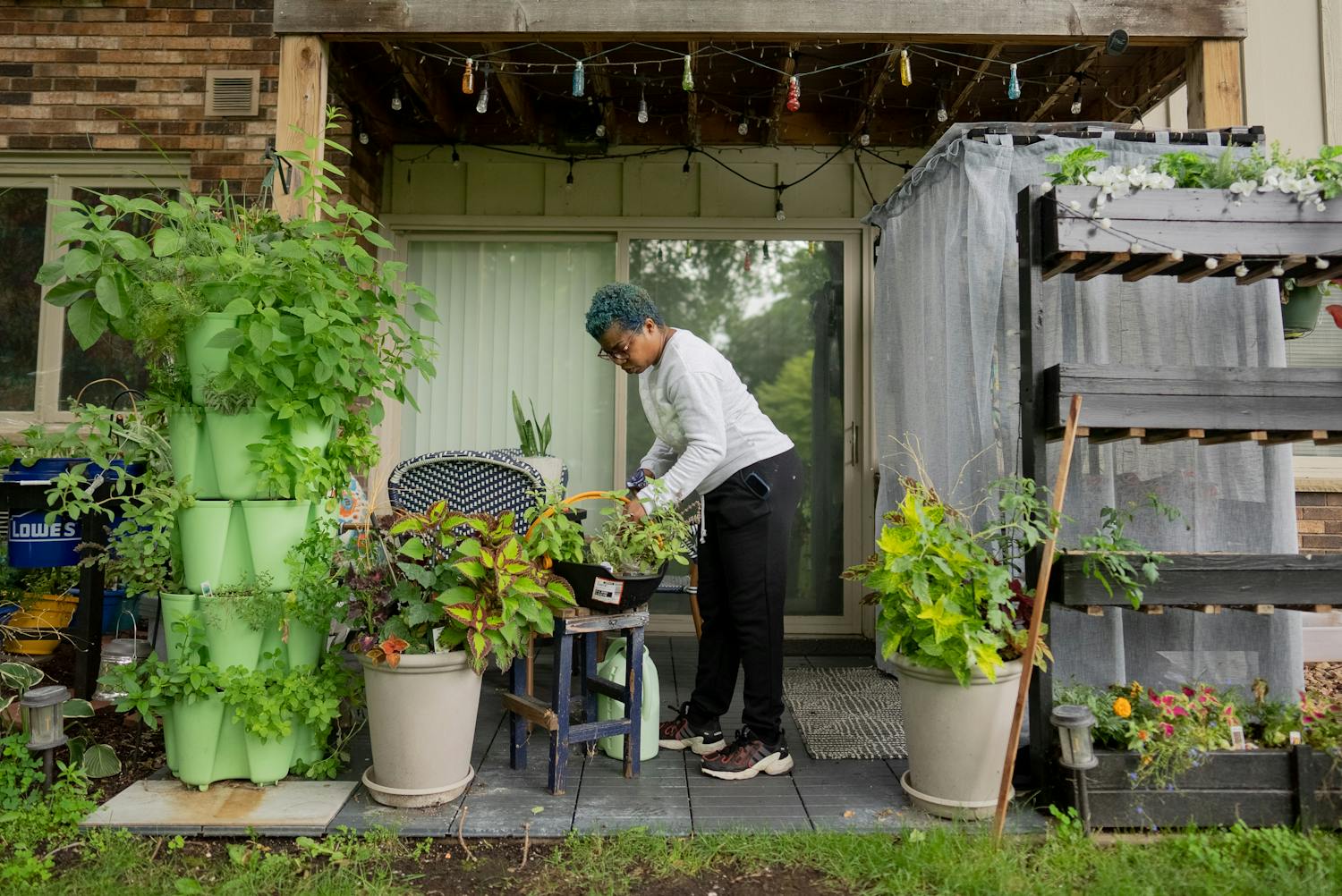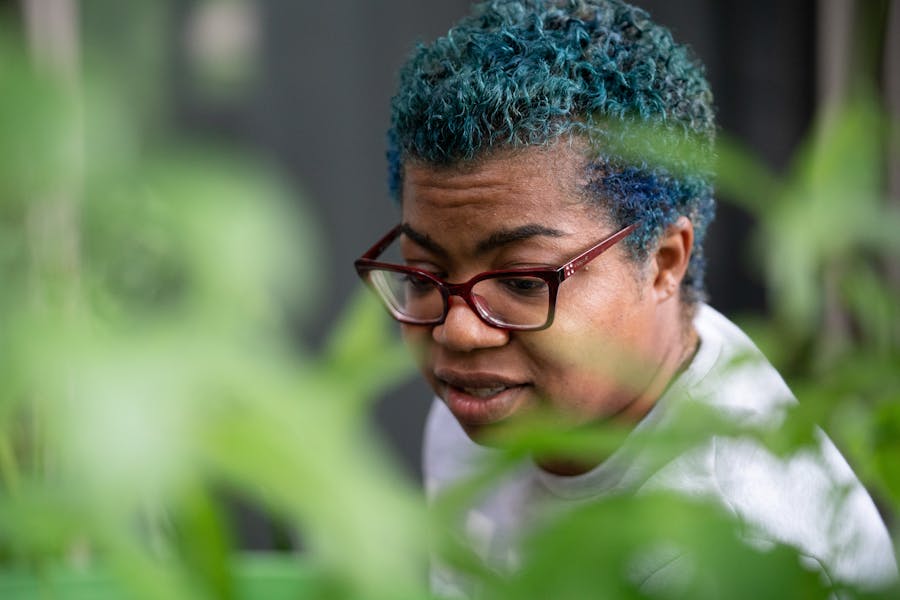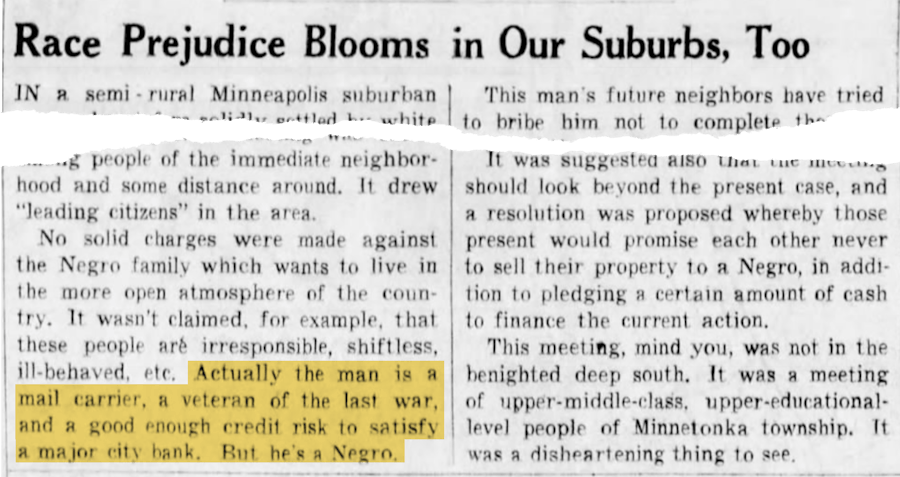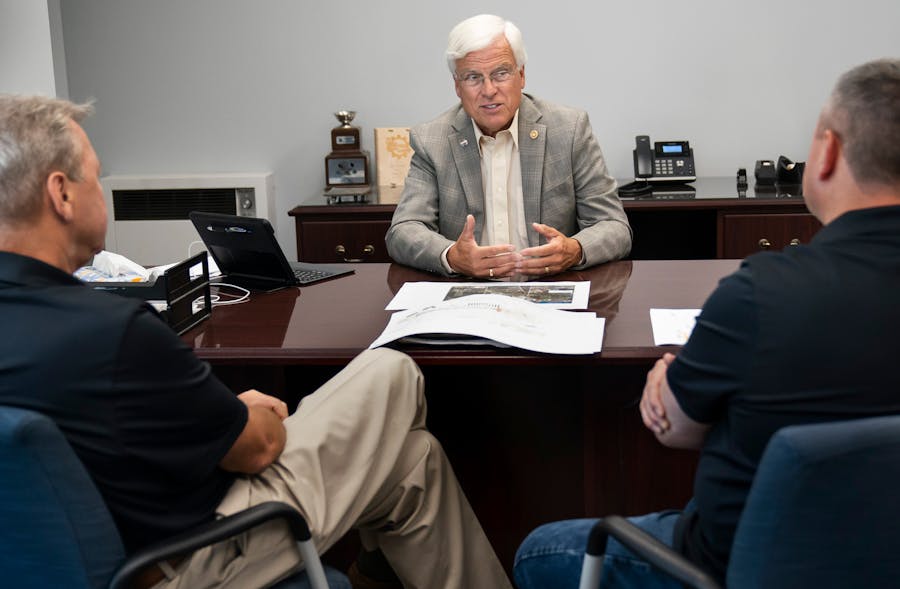Liz Stroder has dreamed of owning a home since she was a teenager. Definitely a garden. Maybe some chickens.
More than anything, the St. Louis Park apartment dweller wants to give her 14-year-old son the stability that comes with homeownership. But Stroder has realized that’s out of her reach, with a median home price in the Twin Cities now topping $350,000 and her income as an insurance underwriting assistant holding stagnant. Those “rose-colored glasses were lifted,” she says.
“There’s a monster being built in front of our cottages!” one woman exclaimed.
“I will not risk my children for this kind of stuff,” said another.
Despite hecklers and a lot of “hatefulness” in the room, Stroder said she felt compelled to speak up for people like herself who cannot afford the American dream of a single-family home.
“I’m used to not being heard because of the fact that I’m a renter, and I’m a Black woman, and I do not make a lot of money, not enough to afford a $400,000 house in St. Louis Park,” Stroder told the mostly white crowd. “Do I not deserve to be here because of that?”
The opposition to
— and to the people who need to live there — that Stroder witnessed that night stems in part from decades of local government land-use rules that prioritize
. Today, however, these rules are increasingly viewed as a major reason that Black and Latino families are essentially shut out of the vast majority of the Twin Cities.
Multifamily housing Multiple housing units in the same building, with shared walls and oftentimes shared common spaces. Typically this refers to buildings with four or more units.
Single-family housing Single-family homes that don’t have a shared wall with the neighboring homes.
“Zoning is being used to regulate who can live in what communities,” said Nelima Sitati Munene, co-chair of the equity advisory committee of the Metropolitan Council, a regional planning agency that promotes and helps finance higher density housing. “We could argue about what the intentions were until kingdom come, but it doesn’t matter. What has this meant for the people who have been excluded all this time? And what has been the impact for the people who have benefited?”

Nelima Sitati Munene, a member of the Metropolitan Council Equity Advisory Committee and executive director of African Career, Education and Resource, attended a picnic with residents of a Brooklyn Center community to discuss tenant issues. Photo by Shari Gross.
None of these
ordinances mention race, but they perpetuate segregation that took root decades ago in an era of more racially explicit housing discrimination. Today, they are seen as a major reason the Twin Cities has some of the nation’s worst disparities in income, wealth and homeownership between white residents and people of color.
Zoning Most cities, townships and some counties have local ordinances that control how land can be used, and zoning is usually part of a larger, long-term plan for orderly growth and change. Typically, in the United States, zoning divides land into areas for residential, commercial, industrial or other uses and often has additional rules regarding lot and building size, parking or secondary structures.
In Minnesota and across the country, a growing number of lawmakers, city planners and advocates for racial equity and housing affordability are pushing cities to drop rules that restrict areas to only single-family housing. They say allowing a
— such as duplexes, triplexes or row houses — when properties are redeveloped would make those single-family neighborhoods accessible to a more diverse population and improve affordability for everyone.
Middle housing This is a relatively new term that encompasses townhomes, rowhomes, duplexes, triplexes or even some fourplexes. This is more dense than single-family housing, but often less dense than multifamily housing. The Star Tribune’s zoning analysis includes mobile homes in this category, as well.
Minneapolis drew national attention in 2018 for being the first city in the nation to loosen single-family zoning rules it said were rooted in racist planning decisions of the past. The state of Oregon and cities such as Berkeley, Sacramento and Charlotte have since adopted similar measures, and officials in Connecticut, California, Atlanta, and Seattle have also debated zoning reforms. President Biden is proposing a $5 billion competitive grant program to encourage cities to eliminate exclusionary zoning practices.
At the Minnesota Capitol, two lawmakers — a Republican and a Democrat — have introduced measures that would either encourage or require cities to allow higher density development.
Even the most ardent advocates admit that zoning reform will not eliminate racial segregation or improve affordability on its own, especially not soon enough to help the current generation.
“I don’t think it’s a panacea,” says Gary Cunningham, a former Metropolitan Council member and longtime leading voice for racial equity in the Twin Cities. “It’s a step in the right direction, but it’s not sufficient.”
Minneapolis shows that change will be slow. Only 23 building permits have been issued for new duplexes or triplexes in places they would not have previously been allowed.
Some of the fully developed first-ring suburbs are starting to follow Minneapolis’ lead, but most suburban leaders believe that they can meet the needs of anyone who wants to live in their communities by zoning land for townhouses and apartment complexes, especially along highways, transit corridors and in commercial areas.
On the fringe of the metro area, where there is still land for development and single-family zoning typically makes up 90% or more of the residential land, city leaders are reluctant to change the character of the cherished single-family neighborhoods.
“People have come out here and expected a certain way of life regarding how much density we have and what it looks like,” said Denny Walsh, mayor of Orono.
Unfounded fears abound that the kind of reform approved by Minneapolis would lead to bulldozing of single-family neighborhoods. Michael Lens, an urban planning associate professor at University of California, Los Angeles from St. Paul, points out that upzoning does not require the addition of duplexes and triplexes but merely removes a long-standing prohibition and gives landowners more flexibility.
“Ending single-family zoning doesn’t end single-family housing. And there’s no real reason why we prioritize single-family housing in such a way,” Lens said. “You can’t have true integration of race and income without a variety of housing types.”



Liz Stroder tended plants in the patio garden she built behind her apartment in St. Louis Park. Stroder said the garden has allowed her to build a community with her neighbors, despite the uncertainty that comes with leasing. Photos by Mark Vancleave.
In 2007, Stroder and her then 1-year-old son moved from Cleveland to the Twin Cities after her best friend from college persuaded her to start a new chapter in her life.
Her friend introduced her to pickled herring and took her out on a frozen lake for the first time. She fell in love with Minnesota.
She has made a home for herself in a 1960s-era apartment complex in St. Louis Park, where she has made friends with her neighbors and tends to the community garden, as well as the flowers, produce and herbs planted in containers on her patio. Her rent has gone up at least 40% in the past decade, though, making it even harder to save for a down payment on a home.
Over the years, Stroder would get excited when she saw a “For Sale” sign on a house in St. Louis Park, thinking maybe that would be her dream home.
Then she looked at the price.
“People who live in rental housing here, they love the city too,” Stroder said in an interview earlier this year. “If they want that dream to own a home and plant more permanent roots here, why isn’t it something you’re trying to make possible for them?”
This is a question that St. Louis Park officials are wrestling with as well. They realized that the 19% of the city’s residents who are people of color are concentrated in the few areas that have apartments.
“BIPOC (Black, Indigenous and People of Color) folks have been segregated from more affluent neighborhoods because they haven’t been able to have more housing options in those neighborhoods,” said Karen Barton, St. Louis Park’s community development director. “That affects education, health, future incomes, everything.”
The Twin Cities metro has become more racially diverse during the past two decades, but people of color, especially Black and Latino, disproportionately live in the relatively small areas zoned for multifamily housing, according to a Star Tribune analysis. Nearly 25% of Black people live in these areas, compared to 15% of Latino and 8% of white people.
Homeownership data also show families of color are having a harder time getting into single-family neighborhoods. Just 25% of Black and 43% of Latino households own their home, compared to about 74% of white households, according to U.S. census data for the seven-county metro.
Twin Cities has wide racial disparities in homeownership
PERCENTAGE OF HOUSEHOLDS IN EACH GROUP WHO OWN THEIR OWN HOME
The gap between Black and white homeownership in Ramsey and Hennepin counties is the largest among metro areas in the nation and has widened in the past 20 years, according to an Urban Institute report released in June.
Single-family neighborhoods are viewed as “high opportunity” areas due to the relative lack of poverty, which has been repeatedly shown in research studies to shape the trajectory of children in important ways. At the same time, the homes generate wealth that can be passed to future generations, feeding a cycle of prosperity that does not exist in neighborhoods with high concentrations of rental property, said Cunningham, who serves as CEO of Prosperity Now, a nonprofit focused on closing the racial wealth divide.
“Not everybody can live where they want to live,” Cunningham said. “They are relegated to certain areas because that’s where the affordable housing is.”
The United States is one of the only countries in the world that uses zoning to separate single-family homes from other housing types, and race was on the minds of its designers, said Jonathan Rothwell, a senior research fellow at the Brookings Institution.
In the early 1900s, city planners — supported by federal housing authorities — wanted to protect all-white neighborhoods that had been created by racially explicit zoning after the Supreme Court ruled those laws unconstitutional. They realized that they could achieve the same goal by barring multifamily housing from those areas since most Black people at the time could not afford to buy a home.
“The problem is that from the very beginning, zoning has treated multifamily housing as akin to a pollutant,” Rothwell said. “It was taken for granted that if you were a well-off or a white family, your children were at risk if they were near a multifamily housing complex.”
Black and Latino residents more likely to live in areas zoned for multifamily
Though there are exceptions, in many Twin Cities suburbs, the areas with concentrations of Black and Latino residents often overlap with areas near highways or where a developer doesn’t have to get special permission to build an apartment building.
The homes that Stroder has been pining for in St. Louis Park tell the story of how this kind of zoning shaped the Twin Cities’ suburbs.
The small, entry-level homes were built to solve a massive housing shortage and provide homes for returning World War II servicemen and their families. Financing was available through the GI Bill, but Black veterans had difficulty getting approved.
Thousands of these new homes built in the first-ring suburbs in the 1940s were also protected by
, snippets of text that developers included in property deeds prohibiting people of color from buying or occupying those properties.
Racial covenants Restrictions that were inserted into property warranty deeds to prevent people of color from buying or occupying property. These were often just a few lines of text added to the deeds by real estate developers. Research by the Mapping Prejudice Project at the University of Minnesota found they were first used in Hennepin County in about 1910. The U.S. Supreme Court deemed the covenants unenforceable in 1948, however covenants remain connected to property deeds in the Twin Cities. The Just Deeds Project is working with homeowners and cities to remove the racial covenants.
Use of racial covenants, starting in 1910, had successfully divided Minneapolis and St. Paul into distinct Black and white neighborhoods that remain evident today, according to data collected by the Mapping Prejudice Project at the University of Minnesota.
As farmland turned to subdivisions, covenants effectively created an invisible wall in the suburbs along Minneapolis’ borders. There were at least 2,400 covenanted homes in St. Louis Park, a city of just 22,000 people by the time racial covenants were deemed unenforceable in 1948.
These covenants worked hand-in-hand with real estate steering, white intimidation and “redlining” — a government-backed effort that designated minority neighborhoods as being high-risk for mortgage lending — to maintain all-white neighborhoods and keep people of color out of homeownership.
In 1952, a Black family that wanted “to live in the more open atmosphere of the country” was met with bribes and threats when they bought a home in what was then Minnetonka Township. Neighbors attempted to halt the purchase and gathered a protest meeting.
A Minneapolis Star editorial about the neighbors’ concerns said, “It wasn’t claimed, for example, that these people are irresponsible, shiftless, ill-behaved, etc. Actually the man is a mail carrier, a veteran of the last war, and a good enough credit risk to satisfy a major city bank. But he’s a Negro.”

The editorial in the Minneapolis Star, which ran on Jan. 30, 1952
In addition to racial covenants, some of these subdivisions had other requirements that are common in modern zoning codes. For example, Golden Valley’s West Tyrol Hills neighborhood, when approved in 1938, mandated only single-family homes, with a garage, costing at least $7,500, according to city planning commission meeting minutes.
As the other more racially explicit forms of housing discrimination were outlawed, single-family zoning came into widespread use by the 1950s.
“Class prejudice and racial prejudice were so intertwined that when suburbs adopted such ordinances, it was impossible to disentangle their motives and to prove that zoning rules violated constitutional prohibitions on race discrimination,” Minneapolis-based public historian Denise Pike, who researches racial housing discrimination, said in a League of Minnesota Cities webinar last year on systemic racism in housing. “The basis of single-family zoning is so tied to racial exclusion and today still excludes people of color.”
The suburbs along Minneapolis’ western border — Edina, St. Louis Park, Robbinsdale and Golden Valley — are artifacts of how single-family zoning perpetuated the segregation created by racial covenants. Those cities now average 18% people of color, well below the 34% average for other first-ring cities, according to a Star Tribune analysis of census data.
All four have 80% or more of their residential land zoned for single-family, well above the 60% average for other first-ring suburbs.
“So much of why things happened the way it happened, especially in the first-ring suburbs, goes back to these racial implications with redlining and racial covenants. Single-family zoning replaced that as a tool to maintain the status quo,” said Jason Zimmerman, Golden Valley’s planning manager.
Left At least 73% of residential land in the Twin Cities metro area is governed by local zoning ordinances that only allow single-family detached homes, like this Prior Lake neighborhood.
Right Only 7% of residential land in the metro allows apartments to be built without special permission. Advocates for allowing multifamily homes in more areas of the metro say it could reduce the need for large complexes such as this one in New Brighton. Photos by Mark Vancleave.
Top At least 73% of residential land in the Twin Cities metro area is governed by local zoning ordinances that only allow single-family detached homes, like this Prior Lake neighborhood.
Bottom Only 7% of residential land in the metro allows apartments to be built without special permission. Advocates for allowing multifamily homes in more areas of the metro say it could reduce the need for large complexes such as this one in New Brighton. Photos by Mark Vancleave.
Even today, proposals for denser development in or near single-family neighborhoods almost always face fierce opposition from nearby homeowners.
The owner of an Apple Valley golf course pitched a plan in 2019 to convert the property to a mix of apartments, townhouses and single-family homes. After several heated public meetings and opposition from planning commission members for that much density, the city ultimately opted in December to rezone the land for what would be considered low to medium density, with no more than 8 units per acre. The city is considering a new proposal for that land calling for about half that density, with 49 townhouses and 27 villas, which are small, single-level homes.
In Prior Lake last year, neighbors objected to a proposal to build 67 townhouses and 27 single-family homes. The townhouses were expected to be priced around $360,000, similar to an adjacent development. Nearby residents said it would bring too much traffic, more car break-ins and unacceptable density.
“If they do build townhomes, what’s that going to do to our property value and our neighborhood? Because it is a beautiful family neighborhood,” one resident of that adjacent development asked at a March 2020 planning commission meeting. “I was told I was in a single-family neighborhood.”
The city’s planning commission rejected the plan because the proposed density of 4.2 units per acre exceeded the 4 units per acre allocated in the city’s land-use plan. The land owner scrapped the proposal.
Prior Lake Mayor Kirt Briggs said his city wants the “diversity and vibrancy” that growth brings, but the city needs to balance that with its ability to provide infrastructure like streets, utilities and parks, and that there’s only so much the city can do to provide housing that everyone can afford. “What we can’t legislate is what the sales price is going to be,” Briggs said.

Doug Anderson, center, has served as Lakeville’s mayor since 2017. “I think the dream of homeownership is alive and well,” he said. “Single-family homes are the motivation for a lot of people.” Photo by Renee Jones Schneider.
Some leaders of suburbs that prioritize single-family homes say that character is the heart of their community, and something that people strive for and want to protect. Lakeville Mayor Doug Anderson said older homes in the city provide affordable options for entry-level buyers and have helped diversify the city’s population, which is about 17% people of color.
“I think the dream of homeownership is alive and well,” Anderson said. “Single-family homes clearly are the motivation for a lot of people.”
Liz Stroder has found a community renting in St. Louis Park, but dreams of a permanent home for her and her son. Video by Mark Vancleave.
As housing prices soar, pressure is growing to loosen zoning’s grip on land use, and it’s coming from both sides of the partisan divide.
With its recent change, Minneapolis joins Osseo and Spring Park as the only cities in the metro that do not have any neighborhoods restricted solely to single-family detached homes. Bloomington also allows duplexes in the majority of its city. St. Louis Park is revising its zoning code to allow duplexes in what are now single-family neighborhoods.
While they have multiple reasons for doing so, city leaders say they are taking a small step to reverse the effects of decades of intentional segregation.
These changes, though, will not alter neighborhoods overnight.
“It’s taken generations to get where we are, and it will take generations to make the changes we’re talking about,” said Golden Valley City Attorney Maria Cisneros.
Cisneros and Golden Valley’s diversity, equity and inclusion manager, Kiarra Zackery, are leading the city’s effort to educate residents about the racial inequities under which their city was created.
Zackery said people living in an upper-middle-class suburb that seems affordable to them and where all their “desirable life outcomes are easily accessible” may have a hard time understanding that the reverse is the reality for other people.
Sen. Rich Draheim, R-Madison Lake, introduced an unsuccessful bill this year that would have encouraged cities to allow duplexes, triplexes or even fourplexes in single-family neighborhoods.
Rep. Steve Elkins, D-Bloomington, wants the House to consider a similar bill requiring cities to allow duplexes in any residential area. Other parts of their bills are aimed at reducing the regulatory approval processes that a builders coalition claims is making it impossible for them to build entry-level-priced homes.
“What have we done to help people? We’ve shoved them in an apartment and not done anything to help them get on a path to homeownership,” Draheim said. “I truly believe this is the best thing we can do to help people get out of poverty. All the money in the world isn’t enough versus helping them build equity in a home.”
Some other inner-ring suburbs are also taking a hard look at their zoning codes. Three years ago, Crystal loosened its lot-size requirements to enable lots to be split during redevelopment. New Brighton launched a steering committee to evaluate its zoning code, which has not been updated since the 1970s. Mayor Kari Niedfeldt-Thomas said she expects that the committee will discuss the inequities and other criticisms of single-family zoning.
Shoreview Mayor Sandy Martin said her city has worked hard over the years to ensure that there is a mixture of housing types and affordability levels. But, like most other suburbs, multifamily housing is kept separate from single-family units, and Martin is seeing how that has shaped the city.
“Shoreview has a very low percentage of people of color, but it can be up to 20 to 30% in some parts of the city,” Martin said.” The prevalence of multifamily housing is where those populations are.”
In St. Louis Park, the opposition of neighbors did not scuttle the project planned for land owned by Union Congregational United Church of Christ. But, in response to the complaints at that March meeting, the developer reduced the proposal to three stories and 60 units. It was approved by the council in June 2020.
The church’s pastor, the Rev. Barb Martin, was disturbed by what she heard at that meeting. She fears it has caused a rift in the neighborhood. The heated complaints were “based on massive assumptions about who is going to live in that apartment building,” Martin later said in an interview. “And it’s all racial.”
Stroder had gone to the meeting as part of her volunteer work with the St. Louis Park Community Housing Team, but she left in tears, feeling that her neighbors “don’t want people who look like me here.”
“Just because people don’t have the same money and access to privilege, how is it that they are a threat to you?” Stroder said, reflecting on the meeting more than a year later.
Stroder, who continues working with the affordable housing group, is pleased that the apartment building got approved, but she is quick to point out that it’s not enough to solve the city’s affordability and segregation problems.
The bigger work that needs to be done, she says, is one of the key things she told the crowd at that meeting: “If the city is going to follow the tenet of being concerned with racial equity and inclusivity, equality ... this is something that all of us have to look into our hearts to find a way to work together to support that.”
Staff writers Eric Roper, Jim Buchta and Jeff Hargarten contributed to this report.
Methodology
To examine residential zoning patterns in the Twin Cities, the Star Tribune requested zoning maps from more than 100 communities that are designated by the Metropolitan Council as urban or suburban and are served by the regional sewer system.
Reporters reviewed zoning ordinances from each city and used information collected from a survey of city planning officials to standardize the residential zoning districts. Each district was assigned to a category based on the most dense form of housing allowed without a conditional use permit or other form of special permission.
The categories were: single-family detached, multifamily housing of more than four units, and districts that allow townhouses, duplexes, triplexes, fourplexes or mobile homes (this is often called “middle housing”). We also identified mixed-use areas that allow both residential and nonresidential use. Areas zoned as a Planned Unit Development were categorized separately since these areas are governed by agreements between a city and a developer, often overriding existing zoning regulations.
This work was conducted in late 2019 just as most cities were in the midst of approving their 2040 Comprehensive Plans. Those plans, which are done every 10 years, can result in zoning changes. The Star Tribune adjusted Minneapolis’ data in its analysis to reflect the city’s decision to allow duplexes or triplexes in zoning districts that previously allowed only single-family homes. This analysis doesn’t reflect any changes that might have occurred in other cities since then.
Read more about our process and download our data on Github.
Introduction video voices
Kiarra Zackery, Diversity, Equity and Inclusion Manager, Golden Valley
Jason Zimmerman, Planning Manager, Golden Valley
Charles Cadenhead, Mayor, Lake Elmo
Nelima Sitati Munene, Executive Director, African Career Education & Resource, Inc.
PeggySue Imihy, Management Analyst in Hopkins
Gary Cunningham, President and CEO, Prosperity Now
Credits
Reporting MaryJo Webster, Michael Corey, Eric Roper, Jim Buchta, Jeff Hargarten
Photography Mark Vancleave, Renee Jones Schneider, Shari Gross
Videography Mark Vancleave
Editing James Eli Shiffer, Eric Wieffering, Katie Moritz, Ginny Greene, Cheryl Diaz Meyer
Graphics Thomas Oide, Michael Corey, C.J. Sinner, Jim Foster
Design Anna Boone, Thomas Oide, Michael Corey
Development Michael Corey, Thomas Oide, Anna Boone, Jamie Hutt
Audience Engagement Tom Horgen, Anna Ta, Ashley Miller

